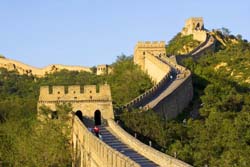|

Beijing is located in the northeastern corner of China. The city limits of Beijing extend some 80km (50mi), including the urban and the suburban areas and the nine counties under its administration - in other words, it's huge.
Beijing is the center of politics, culture and international exchanges and a modern metropolis full of vitality. For the history buffs, Beijing is a living museum. Beijing has something for everyone.
Private Beijing tours + hotel Tours only Beijing + China Tour Though it may not appear so in the shambles of arrival, Beijing is a place of very orderly design. Long, straight boulevards and avenues are crisscrossed by a network of lanes. Places of interest are either very easy to find if they are on the avenues, or impossible to find if they are buried down the hutongs (narrow alleys).
Beijing is the center of politics, culture and international exchanges and a modern metropolis full of vitality. The world's earliest description of Beijing came in the travel notes of Marco Polo, the young Italian traveler, in the 13th century. His observations of people's civilized and well-to-do life in Beijing and his admiration for the beauty of the city have for hundreds of years induced the reverie of numerous people about this ancient capital of civilization in the East.
Beijing has something for everyone. For the history buffs, Beijing is a living museum, filled with countless palaces, tombs, and temples left from centuries of Imperial rule. For foreign students and scholars, Beijing boasts two world-renowned universities as well as dozens of top-tier language institutions. For culinary enthusiasts, Beijing greets you with her mouth-watering Peking duck. For the culturally inclined, Beijing offers the bright faces and unique sounds of the Beijing Opera. For those seeking retail therapy, Beijing is a shopping haven. For nature lovers, Beijing has hiking trails, many tranquil parks, and of course you can climb the greatest wall in the world! For sports fans, Beijing bustles with the preparations of the 2008 Olympics.
Four Great Buildings to Shape 2008 Olympic Beijing
Beijing has both excellent and classical architecture but few distinguished modern buildings. Now such world famous architects as Ram Koolhass, de Meuron, Paul Andrew and PTW Architects are to display their skills here. With the speeding up of China's urbanization and the challenging concept of the 2008 Olympic Games, almost all famous design consortiums from around the world have found that China is one of the few countries which provides not only imaginary space but also abundant funds for modern architecture today. Therefore, Ram Koolhass's "door", Herzog and de Meuron's "bird-nest", Paul Andrew's "eggshell" and PTW Architects' "water cube" are just a small part of the skills displayed by famous architects in China. The Four Great Buildings are as below:
1. National Stadium--natural "Bird Nest"
2. National Aquatics Centre--exquisite and exciting "Water Cube"
3. New CCTV site--unconventional "Z crisscross"
4. National Grand Theater--Paul Andrew's "Eggshell"
Beijing joins World Architecture Trend
Wang Mingxian, deputy chief of the Environment Art Committee of the China Construction Culture and Art Association, said: "In recent years, Beijing has taken big steps in introducing modern architecture at a high level."
"People hold different opinions about whether the large-scale introduction of variously styled architecture from global competitors will make Beijing an experimental area of foreign architecture. In regard to the underdeveloped modern architecture of Beijing, we first have a welcome attitude. However the needs of city planning as well as historical protection require combining old with new."
Daily Private Tours and Join-in Tours (also called seat in coach tours) available, please kindly check the list below, and tell us which one you like, or you might ask us to tailor make a special Beijing Holiday for you.
 China Tours inclusive of visiting Beijing China Tours inclusive of visiting Beijing
|
|